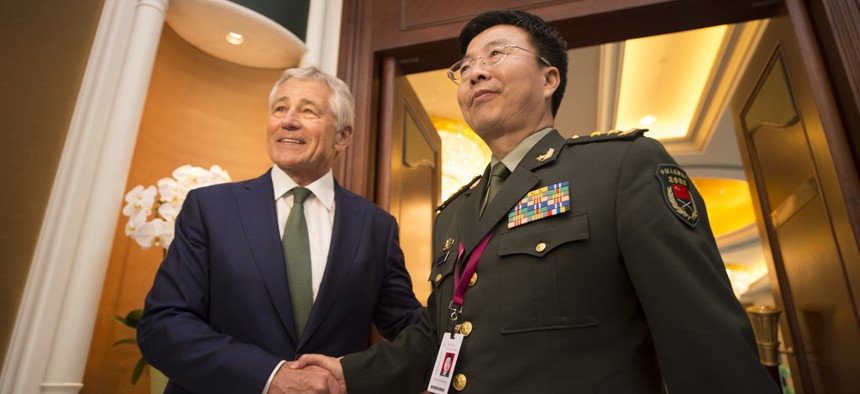
Defense Secretary Chuck Hagel meets with Lt. Gen. Wang Guanzhong, the deputy chief of the General Staff of China at the Shangri-La Dialogue in Singapore on Saturday. DOD Photo by Marine Sgt. Aaron Hostutler
Still a Long Way from Asian NATO
‘Collective security’ is the trending phrase in Asia, but what comes next is not so clear. By Kevin Baron
SINGAPORE -- Don’t call it Asian NATO. Not yet. But something is brewing in the Asia-Pacific region lately and it feels like the birth of a new collective security architecture. Or maybe, just the conception.
For several years at the annual Shangri-La Dialogue conference of defense ministers, the United States and other major powers have pushed intently for a larger, shared security system that moves beyond the hub-and-spoke and the old, complex network of one-to-one relationships of the past. With Defense Secretary Chuck Hagel leading the Pentagon, there’s an even greater sense of purpose to that mission. Hagel is one of Washington’s biggest proponents of alliances, he led a congressional delegation to the first gathering of this body more than a decade ago, and he already has made five trips to Asia since taking office early last year.
Washington’s urgency of wanting Asian nations to unite their defenses has a long way to go to overcome the reality of ancient animosities, but the U.S. is pushing hard and some Asian defense ministers are starting to become believers.

"We must encourage our allies to move beyond bilateral alliances and towards an era of greater multilateral security cooperation. We have too many shared interests and too much is at stake,” Joint Chiefs Chairman Gen. Martin Dempsey told Defense One, in Singapore. “Whatever any future security construct may be, it need not be exclusive, but expansive enough for all nations who value the rule of law and stability and prosperity in the region."
That statement is a bluntly coded message to China saying the People’s Liberation Army does not have to find itself excluded from future Asian military alliances and using its military to stake territorial claims and provoke its neighbors, rather than diplomacy and international law, isn’t helping.
Publicly, Pentagon officials are pushing for the Association of Southeast Asian Nations, or ASEAN, to be included at the center of any future security arrangements for the region. Amy Searight, deputy assistant secretary of defense for South and South East Asia, said that the ASEAN Defense Ministers Meeting, or ADMM+, shows the region wants something more. “It’s moved from concept to reality in only 4 short years,” she said during a panel discussion about the future of a regional security structure. “There still are a lot of challenges in the region…these are all challenges that can’t be tackled alone.”
How Asian militaries work together today, she said, will help set precedent and build a more permanent structure for the future.
But others are far more skeptical that a diplomatic body like ASEAN can be the birthplace of a military alliance. Tim Huxley, executive director of IISS-Asia, moderating the panel, called it “a very upbeat and encouraging assessment of ASEAN.”
Privately, U.S. officials realize they are playing a long game. A senior military official told Defense One, “Talking with our team, no one expects this region to move to a NATO-type security architecture anytime in the near future. Would require a significant forcing function for that to happen.”
In other words, that “forcing function” has not arrived – not in China’s military buildup, not in its South China Sea provocations, and not anywhere else, including North Korea.
“There is no overarching strategy or design when it comes to order in the region,” said Sihasak Phuangketkeow, Thailand’s permanent secretary of foreign affairs. ASEAN must play a more proactive role, he said, and remain central to regional security but, he said, “We’re really not clear what it’s all about…Sometimes we meet, we talk about the schedule but we don’t have the time to talk about the substance.”
Some ministers seemed to say that if ASEAN is to be the seed for something new, that alliance must become something new – something with teeth. “ASEAN can no longer be neutral, when it comes to the major powers. At the same time, we cannot be seen as taking sides,” Phuangketkeow said. “So, this is the challenge for ASEAN.”
"To succeed we're going to need a level of statecraft of the highest order, especially from the major powers,” said an even more skeptical sounding Peter Varghese, Australia's foreign affairs and trade secretary.
“ASEAN has a short memory, we don’t carry too many baggages [sic] from the past,” said Dino Patti Djalal, former Indonesian ambassador to the U.S. He argued that other powers would take ASEAN more seriously if it does speak and act with one voice. “But it does require changing the diplomatic culture of ASEAN.”
ASEAN does have its defenders. “Just try to imagine this region without ASEAN” said Kishore Mahbubani, dean of public policy at the National University of Singapore, who argued that Asia has done a better job of managing geopolitical differences than Europe, recently, and called the Ukraine crisis a “total failure” of Europe’s institutions.
One thing is apparent, however. If China is not concerning enough to spur the rest of the Asia-Pacific nations into a new collective security alliance, the same is true in the reverse. In closed-door meetings with Hagel, there was no pushback from the Chinese delegation here to the collective security movement surrounding them, said a senior defense official. More immediate issues were discussed.
NEXT STORY: Like Us on Facebook
